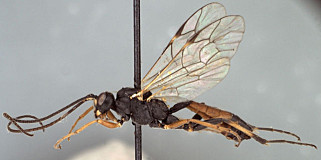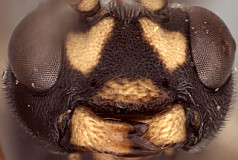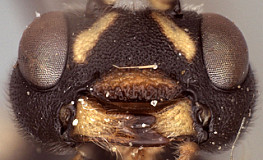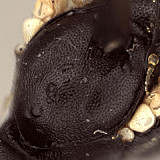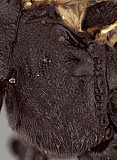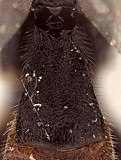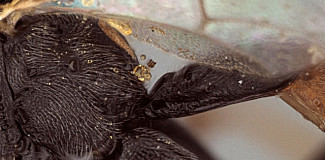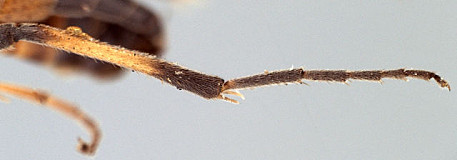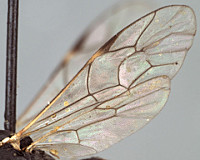Frons without median horn or elevated carina. Clypeus broad, surface weakly bulging, nearly flat, heavily rugose-punctate (Figs 2, 3); ventral margin blunt throughout, evenly convex; epistomal sulcus shallow, weakly indicated. Malar space (Fig. 2) slightly longer than half basal width of mandible. Mandible (Fig. 3) moderately long, curved, tapering gradually from base to about midpoint, parallel-sided to slightly broadening from midpoint to apex, ventral tooth longer than dorsal tooth. Ocelli small, maximum diameter of lateral ocellus shorter than distance between ocellus and eye. Maxillary palps much shorter than head height. Male antenna slightly longer than body; first flagellomere not much longer than second (Fig. 1). Hypostomal carina joining occipital carina above base of mandible; occipital carina complete. Dorsal end of epicnemial carina extending to anterior margin of mesopleuron or narrowly separated therefrom as in Fig. 5; mesopleuron densely but finely granular punctate ventrally. Notaulus distinctly though not sharply impressed on anterior declivity, weaker on disk but long, broadly converging near posterior margin. Pleural carina complete, varying from weak to well-developed; propodeal carinae mostly obscured by dense, granular sculpture, often with traces of median longitudinal carinae extending from posterior margin. Legs without apical comb on posterior side of hind tibia; hind tibial spurs very short, slender, longest spur less than 0.3 times length of hind basitarsus (Fig. 8); all tarsal claws simple, not pectinate. Fore wing areolet present in two of three specimens examined, completely absent (Fig 9) in the third specimen; stigma (Fig. 9) narrow, with Rs+2r arising slightly basad midpoint; 1cu-a often interstitial with Rs+M. Hind wing (Fig. 9) with first abscissa of CU1 about 4 times longer than 1cu-a. T1 (Figs 6, 7) broad, gradually widening posteriorly; dorsal carinae distinct near deep basal depression for dorsal tendon attachment, in one of three specimens indicated as low, rounded ridges extending to or slightly posteriorad level of spiracle, present only basally in other two specimens; dorsal-lateral carina well-developed basad spiracle, difficult to distinguish among heavy sculpture posteriorly; glymma deep, broad basally, narrowing posteriorly. S1 short, extending about 0.35 times length of T1. T2 thyridium present; laterotergites of T2 and T3 completely separated by creases. The only known species is fairly robust compared to the slender species of
Alexeter.
The above description is based in part on Townes (1970) but largely on three male specimens: two from the Texas A&M collection and one from the Canadian National Collection.
1.
Azelus erythropalpus habitus, m...
Azelus erythropalpus habitus, male
↰
↴
2.
Azelus erythropalpus face and clypeus...
Azelus erythropalpus face and clypeus
↰
↴
3.
Azelus erythropalpus mandibles and clypeus...
Azelus erythropalpus mandibles and clypeus
↰
↴
4.
Azelus erythropalpus mes...
Azelus erythropalpus mesoscutum
↰
↴
5.
Azelus erythropa...
Azelus erythropalpus Mesopleuron
↰
↴
6.
Azelus erythropa...
Azelus erythropalpus T1 dorsal view
↰
↴
7.Azelus erythropalpus T1
8.
Azelus erythropalpus hind leg...
Azelus erythropalpus hind leg
↰
↴
9.
Azelus erythropalpus wings...
Azelus erythropalpus wings
↰
↴
10.
Azelu...
Azelus erythropalpus
↰
↴

